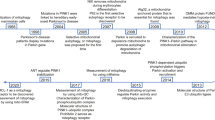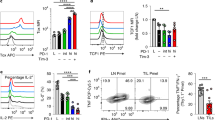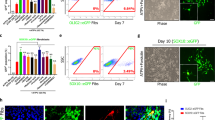Abstract
Mitochondrial defects, affecting parameters such as mitochondrial number and shape, levels of respiratory chain complex components and markers of oxidative stress, have been associated with the appearance and progression of multiple sclerosis. Nevertheless, mitochondrial physiology has never been monitored during oligodendrocyte progenitor cell (OPC) differentiation, especially in OPCs challenged with proinflammatory cytokines. Here, we show that tumor necrosis factor alpha (TNF-α) inhibits OPC differentiation, accompanied by altered mitochondrial calcium uptake, mitochondrial membrane potential, and respiratory complex I activity as well as increased reactive oxygen species production. Treatment with a mitochondrial uncoupler (FCCP) to mimic mitochondrial impairment also causes cells to accumulate at the progenitor stage. Interestingly, AMP-activated protein kinase (AMPK) levels increase during TNF-α exposure and inhibit OPC differentiation. Overall, our data indicate that TNF-α induces metabolic changes, driven by mitochondrial impairment and AMPK activation, leading to the inhibition of OPC differentiation.
Similar content being viewed by others
Log in or create a free account to read this content
Gain free access to this article, as well as selected content from this journal and more on nature.com
or
Abbreviations
- AMPK:
-
AMP-activated protein kinase
- ATP:
-
adenosine triphosphate
- bFGF:
-
basic fibroblast growth factor
- Ca2+:
-
calcium
- CCh:
-
carbachol
- cytAEQ:
-
cytoplasmic aequorin
- FCCP:
-
carbonyl cyanide 4-(trifluoromethoxy)phenylhydrazone
- mTOR:
-
mechanistic target of rapamycin
- FRET:
-
Förster resonance energy transfer
- GFAP:
-
glial fibrillary acid protein
- IFN-γ:
-
interferon gamma
- MBP:
-
myelin basic protein
- mtAEQ:
-
mitochondrial aequorin
- MS:
-
multiple sclerosis
- NG2:
-
chondroitin sulfate proteoglycan4
- OPCs:
-
oligodendrocyte progenitor cells
- OSP:
-
oligodendrocyte-specific protein
- O4:
-
oligodendrocyte marker 4
- PDGF:
-
platelet-derived growth factor
- ROS:
-
reactive oxygen species
- TMRM:
-
tetramethylrhodamine methyl ester
- TNF-α:
-
tumor necrosis factor alpha
- T3:
-
triiodothyronine
References
Ghafourifar P, Mousavizadeh K, Parihar MS, Nazarewicz RR, Parihar A, Zenebe WJ . Mitochondria in multiple sclerosis. Front Biosci 2008; 13: 3116–3126.
Bonora M, Patergnani S, Rimessi A, De Marchi E, Suski JM, Bononi A et al. ATP synthesis and storage. Purinergic Signal 2012; 8: 343–357.
Marchi S, Giorgi C, Suski JM, Agnoletto C, Bononi A, Bonora M et al. Mitochondria-ros crosstalk in the control of cell death and aging. J Signal Transduct 2012; 2012: 329635.
Schoenfeld R et al. Oligodendroglial differentiation induces mitochondrial genes and inhibition of mitochondrial function represses oligodendroglial differentiation. Mitochondrion 2010; 10: 143–150.
Rinholm JE, Hamilton NB, Kessaris N, Richardson WD, Bergersen LH, Attwell D . Regulation of oligodendrocyte development and myelination by glucose and lactate. J Neurosci 2011; 31: 538–548.
Benarroch EE . Oligodendrocytes: susceptibility to injury and involvement in neurologic disease. Neurology 2009; 72: 1779–1785.
Selmaj K, Raine CS, Cannella B, Brosnan CF . Identification of lymphotoxin and tumor necrosis factor in multiple sclerosis lesions. J Clin Invest 1991; 87: 949–954.
Musabak U, Demirkaya S, Genc G, Ilikci RS, Odabasi Z . Serum adiponectin, TNF-alpha, IL-12p70, and IL-13 levels in multiple sclerosis and the effects of different therapy regimens. Neuroimmunomodulation 2011; 18: 57–66.
Vladić A, Horvat G, Vukadin S, Sučić Z, Šimaga Š . Cerebrospinal fluid and serum protein levels of tumour necrosis factor-alpha (TNF-α), interleukin-6 (IL-6) and soluble interleukin-6 receptor (sIL-6R gp80) in multiple sclerosis patients. Cytokine 2002; 20: 86–89.
Koopman WJH, Nijtmans LG, Dieteren CE, Roestenberg P, Valsecchi F, Smeitink JA et al. Mammalian mitochondrial complex I: biogenesis, regulation, and reactive oxygen species generation. Antioxid Redox Signal 2010; 12: 1431–1470.
Chen Y, Balasubramaniyan V, Peng J, Hurlock EC, Tallquist M, Li J et al. Isolation and culture of rat and mouse oligodendrocyte precursor cells. Nat Protoc 2007; 2: 1044–1051.
Zhang X, Haaf M, Todorich B, Grosstephan E, Schieremberg H, Surguladze N et al. Cytokine toxicity to oligodendrocyte precursors is mediated by iron. Glia 2005; 52: 199–208.
Agresti C, Meomartini ME, Amadio S, Ambrosini E, Volonté C, Aloisi F et al. ATP regulates oligodendrocyte progenitor migration, proliferation, and differentiation: involvement of metabotropic P2 receptors. Brain Res Brain Res Rev 2005; 48: 157–165.
Itoh K . Culture of oligodendrocytes precursor cells (NG2+ /O1-) and oligodendrocytes (NG2- /O1+) from embryonic rat cerebrum. Brain Res Protoc 2002; 10: 23–30.
Pinton P, Rimessi A, Romagnoli A, Prandini A, Rizzuto R . Biosensors for the detection of calcium and pH. Methods Cell Biol 2007; 80: 297–325.
Bonora M, Giorgi C, Bononi A, Marchi S, Patergnani S, Rimessi A et al. Subcellular calcium measurements in mammalian cells using jellyfish photoprotein aequorin-based probes. Nat Protoc 2013; 8: 2105–2118.
Palmer AE, Tsien RY . Measuring calcium signaling using genetically targetable fluorescent indicators. Nat Protoc 2006; 1: 1057–1065.
Popko B, Baerwald KD . Oligodendroglial response to the immune cytokine interferon gamma. Neurochem Res 1999; 24: 331–338.
Bonora M, Bononi A, De Marchi E, Giorgi C, Lebiedzinska M, Marchi S et al. Role of the c subunit of the FO ATP synthase in mitochondrial permeability transition. Cell Cycle 2013; 12: 674–683.
Suski JM, Lebiedzinska M, Bonora M, Pinton P, Duszynski J, Wieckowski MR . Relation between mitochondrial membrane potential and ROS formation. Methods Mol Biol 2012; 810: 183–205.
Mao C, Kisaalita WS . Determination of resting membrane potential of individual neuroblastoma cells (IMR-32) using a potentiometric dye (TMRM) and confocal microscopy. J Fluoresc 2004; 14: 739–743.
Tanaka M, Davidson M, Yen HC, Suenaga S, Tomita K, Nishii T et al. Evidence of ROS generation by mitochondria in cells with impaired electron transport chain and mitochondrial DNA damage. Mitochondrion 2007; 7: 106–118.
Higuchi M, Proske RJ, Yeh ET . Inhibition of mitochondrial respiratory chain complex I by TNF results in cytochrome c release, membrane permeability transition, and apoptosis. Oncogene 1998; 17: 2515–2524.
Willems PHGM, Valsecchi F, Distelmaier F, Verkaart S, Visch HJ, Smeitink JA et al. Mitochondrial Ca2+ homeostasis in human NADH:ubiquinone oxidoreductase deficiency. Cell Calcium 2008; 44: 123–133.
Distelmaier F, Visch HJ, Smeitink JA, Mayatepek E, Koopman WJ, Willems PH . The antioxidant Trolox restores mitochondrial membrane potential and Ca2+ -stimulated ATP production in human complex I deficiency. J Mol Med (Berl) 2009; 87: 515–522.
Bolster DR, Crozier SJ, Kimball SR, Jefferson LS . AMP-activated protein kinase suppresses protein synthesis in rat skeletal muscle through down-regulated mammalian target of rapamycin (mTOR) signaling. J Biol Chem 2002; 277: 23977–23980.
Tyler Wa, Gangoli N, Gokina P, Kim HA, Covey M, Levison SW et al. Activation of the mammalian target of rapamycin (mTOR) is essential for oligodendrocyte differentiation. J Neurosci 2009; 29: 6367–6378.
Navikas V, Link H . Review: cytokines and the pathogenesis of multiple sclerosis. J Neurosci Res 1996; 45: 322–333.
Huang Y, Erdmann N, Peng H, Zhao Y, Zheng J . The role of TNF related apoptosis-inducing ligand in neurodegenerative diseases. Cell Mol Immunol 2005; 2: 113–122.
Vladic A, Horvat G, Vukadin S, Sucic Z, Simaga S . Cerebrospinal fluid and serum protein levels of tumour necrosis factor-alpha (TNF-alpha) interleukin-6 (IL-6) and soluble interleukin-6 receptor (sIL-6 R gp80) in multiple sclerosis patients. Cytokine 2002; 20: 86–89.
Cammer W, Zhang H . Maturation of oligodendrocytes is more sensitive to TNF alpha than is survival of precursors and immature oligodendrocytes. J Neuroimmunol 1999; 97: 37–42.
Scolding N . Oligodendrocyte progenitors are present in the normal adult human CNS and in the lesions of multiple sclerosis. Brain 1998; 121: 2221–2228.
Wolswijk G . Oligodendrocyte precursor cells in the demyelinated multiple sclerosis spinal cord. Brain 2002; 125: 338–349.
Kuhlmann T, Miron V, Cui Q, Wegner C, Antel J, Brück W . Differentiation block of oligodendroglial progenitor cells as a cause for remyelination failure in chronic multiple sclerosis. Brain 2008; 131: 1749–1758.
Fünfschilling U, Supplie LM, Mahad D, Boretius S, Saab AS, Edgar J et al. Glycolytic oligodendrocytes maintain myelin and long-term axonal integrity. Nature 2012; 485: 517–521.
Ziabreva I, Campbell G, Rist J, Zambonin J, Rorbach J, Wydro MM et al. Injury and differentiation following inhibition of mitochondrial respiratory chain complex IV in rat oligodendrocytes. Glia 2010; 58: 1827–1837.
Marchi S, Pinton P . The mitochondrial calcium uniporter complex: molecular components, structure and physiopathological implications. J Physiol 2014; 592: 829–839.
Harding AE, Sweeney MG, Miller DH, Mumford CJ, Kellar-Wood H, Menard D et al. Occurrence of a multiple sclerosis-like illness in women who have a Leber’s hereditary optic neuropathy mitochondrial DNA mutation. Brain 1992; 115 (Pt 4): 979–989.
Vanopdenbosch L, Dubois B, D’Hooghe MB, Meire F, Carton H . Mitochondrial mutations of Leber’s hereditary optic neuropathy: a risk factor for multiple sclerosis. J Neurol 2000; 247: 535–543.
Chen Q, Vazquez EJ, Moghaddas S, Hoppel CL, Lesnefsky EJ . Production of reactive oxygen species by mitochondria: central role of complex III. J Biol Chem 2003; 278: 36027–36031.
Szolnoki Z, Kondacs A, Mandi Y, Bodor A, Somogyvari F . A homozygous genetic variant of mitochondrial uncoupling protein 4 exerts protection against the occurrence of multiple sclerosis. Neuromolecular Med 2009; 11: 101–105.
Szolnoki Z . Common genetic variants of the mitochondrial trafficking system and mitochondrial uncoupling proteins affect the development of two slowly developing demyelinating disorders, leukoaraiosis and multiple sclerosis. Curr Med Chem 2010; 17: 3583–3590.
Szolnoki Z, Kondacs A, Mandi Y, Bodor A, Somogyvari F . A homozygous genetic variant of mitochondrial uncoupling protein 4 affects the occurrence of leukoaraiosis. Acta Neurol Scand 2011; 123: 352–357.
Otaegui D, Saenz A, Ruiz-Martinez J, Olaskoaga J . & López de Munain, A. UCP2 and mitochondrial haplogroups as a multiple sclerosis risk factor. Mult Scler 2007; 13: 454–458.
Wu S-B, Wei Y-H . AMPK-mediated increase of glycolysis as an adaptive response to oxidative stress in human cells: implication of the cell survival in mitochondrial diseases. Biochim Biophys Acta 2012; 1822: 233–247.
Alers S, Löffler AS, Wesselborg S, Stork B . Role of AMPK-mTOR-Ulk1/2 in the regulation of autophagy: cross talk, shortcuts, and feedbacks. Mol Cell Biol 2012; 32: 2–11.
Díaz-Troya S, Pérez-Pérez ME, Florencio FJ, Crespo JL . The role of TOR in autophagy regulation from yeast to plants and mammals. Autophagy 2008; 4: 851–865.
Chen Y, Balasubramaniyan V, Peng J, Hurlock EC, Tallquist M, Li J et al. Isolation and culture of rat and mouse oligodendrocyte precursor cells. Nat Protoc 2007; 2: 1044–1051.
Bradford MM . A rapid and sensitive method for the quantitation of microgram quantities of protein utilizing the principle of protein-dye binding. Anal Biochem 1976; 72: 248–254.
Acknowledgements
We would like to thank Dr. Lara Bighi and Augusto Bevilacqua for their extraordinary help. This research was supported by Fondazione Italiana Sclerosi Multipla (FISM), with fellowships to AB (2010/B/1) and to SP (Cod. 2012/B/11) and with the grant FISM 2008/R/18 to PP. AR and CG are supported by the Italian Ministry of Health and Associazione Italiana per la Ricerca sul Cancro (AIRC), respectively. JMS, JD, and MRW are supported by a grant from the Polish National Science Centre, UMO-2011/01/M/NZ3/02128, BIO-IMAGing in Research Innovation and Education (FP7-REGPOT-2010-1). JMS is also supported by a Ph.D. fellowship from the Foundation for Polish Science (FNP), UE, European Regional Development Fund and Operational Programme ‘Innovative Economy’. TP is supported by the Italian Ministry of Education (PRIN and FIRB projects) and the CNR project ‘Aging’. PP is financed by AIRC; Telethon (GGP11139B); the Italian Ministry of Education, University and Research; and the Italian Ministry of Health.
Author information
Authors and Affiliations
Corresponding author
Ethics declarations
Competing interests
The authors declare no conflict of interest.
Additional information
Edited by L Scorrano
Supplementary Information accompanies this paper on Cell Death and Differentiation website
Supplementary information
Rights and permissions
About this article
Cite this article
Bonora, M., De Marchi, E., Patergnani, S. et al. Tumor necrosis factor-α impairs oligodendroglial differentiation through a mitochondria-dependent process. Cell Death Differ 21, 1198–1208 (2014). https://doi.org/10.1038/cdd.2014.35
Received:
Revised:
Accepted:
Published:
Issue date:
DOI: https://doi.org/10.1038/cdd.2014.35
This article is cited by
-
Early adversity causes sex-specific deficits in perforant pathway connectivity and contextual memory in adolescent mice
Biology of Sex Differences (2024)
-
Discovery of a brain penetrant small molecule antagonist targeting LPA1 receptors to reduce neuroinflammation and promote remyelination in multiple sclerosis
Scientific Reports (2024)
-
Recent Reports on Redox Stress-Induced Mitochondrial DNA Variations, Neuroglial Interactions, and NMDA Receptor System in Pathophysiology of Schizophrenia
Molecular Neurobiology (2022)
-
Assembly and comparative analysis of the complete mitochondrial genome of Suaeda glauca
BMC Genomics (2021)
-
Citrullinated myelin induces microglial TNFα and inhibits endogenous repair in the cuprizone model of demyelination
Journal of Neuroinflammation (2021)



